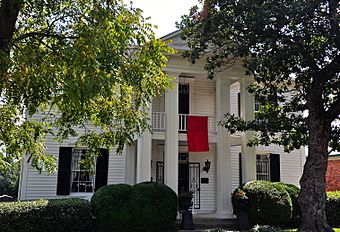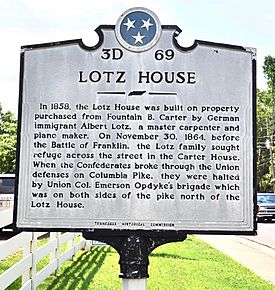Lotz House facts for kids
Quick facts for kids |
|
|
Lotz House
|
|

Lotz House, September 2014.
|
|
| Location | 1111 Columbia Ave., Franklin, Tennessee |
|---|---|
| Area | 0.3 acres (0.12 ha) |
| Built | 1858 |
| NRHP reference No. | 76001809 |
| Added to NRHP | December 12, 1976 |
The Lotz House (say "boats" for "Lotz") is a two-story wooden house built in 1858 in Franklin, Tennessee. It's famous because it was right in the middle of the fierce Battle of Franklin during the American Civil War in 1864. Today, it's a museum that teaches visitors about this important time in history.
Contents
History of the Lotz House
A Family Caught in Battle
On November 30, 1864, the Lotz family was surprised to see thousands of Union soldiers marching past their home in Franklin. These soldiers were heading north to Nashville, Tennessee. However, they couldn't cross the Harpeth River because it was flooded.
Suddenly, about 20,000 Confederate soldiers attacked. Union troops quickly set up defenses right across the Lotz property and the nearby Carter property.
Hiding from the Fight
The Lotz family quickly ran across the street to the Carter House. Both families hid together in the Carter's basement. From there, they heard a five-hour battle. It was intense, with a lot of hand-to-hand fighting. This battle is known as one of the bloodiest of the Civil War. About 10,000 soldiers were killed or wounded.
After the Battle
The Lotz House was badly damaged. The south wall was blown away, and cannon fire made holes in the roof and floors. But the house was still standing. After the battle, it was used as a field hospital to care for the wounded. Albert Lotz, the owner, later supervised the repairs.
Over the next 100 years, many different people owned the house. It slowly fell apart. In 1974, the Heritage Society of Franklin and Williamson Counties bought it. They wanted to save it from being torn down.
Becoming a Museum
The Lotz House was added to the National Register of Historic Places in 1976. This was the start of its restoration. In 2008, the Lotz House opened to the public as a historical museum. It is run by a private, non-profit group.
About Albert Lotz and His Home
A Master Woodworker
Johann Albert Lotz was born in Germany in 1820. He was a very skilled woodworker. He had worked his way up in the German guild system to become a "master craftsman". He moved to the United States in 1848 to join other family members. He met his wife, Margaretha, in New Orleans.
They eventually moved to Franklin, Tennessee, near Nashville. They bought about 5 acres (2.0 ha) of land. This was a small piece of a much larger 300 acres (120 ha) property. That larger property belonged to Fountain Branch Carter, who lived in a brick home across the street.
Building the House
Albert Lotz built his two-story wooden house himself. He did not use enslaved labor. Historians have wondered why Carter sold such a small piece of land so close to his own home. One historian, J.T. Thompson, thought the land was too rocky for farming. He said Carter was happy to sell the "unproductive real estate" to Lotz.
The Lotz House is a white building with four columns. It is built in the Greek Revival style. You can find it at 1111 Columbia Avenue in Franklin. The way it was built and the furniture inside show Lotz's amazing woodworking skills. For example, there are three fireplaces with designs from simple to very detailed. There's also a solid black walnut handrail that wraps around the staircase. Lotz also made furniture, cabinets, and even pianos.
Albert and Margaretha had six children: Paul and Amelia (from a previous marriage), Augustus, Matilda, and twins Julius and Julia.
The Battle of Franklin (1864)
Preparing for Conflict
In early 1864, the Union Army expected a Confederate attack. They started moving many soldiers into the area around the Carter and Lotz houses. To prepare, Union soldiers built defenses. They cut down every tree to prevent Confederate snipers from hiding. Some accounts suggest they also poisoned much of the water supply.
The Lotz twins, Julius and Julia, went to play at a nearby stream. They were later found dead. Some historical accounts suggest they might have been affected by poisoned water. However, not all historians agree, and some believe they may have drowned.
The Day of the Battle
On the day of the battle, the Lotz family was first surprised to see a long line of Union troops and supply wagons. Around 2 p.m., from their front yard, they saw thousands of Confederate soldiers. They looked like a "tidal wave" covering two miles of open fields.
The Lotz family quickly took refuge in the cellar of the Carter House across the street. Their own house didn't have a safe hiding place. Albert Lotz managed to save some of his tools before hiding. The battle lasted for five hours. It is known as one of the bloodiest battles of the Civil War. By nightfall, six Confederate generals were dead or dying.
Aftermath of the Fight
When the two families came out of the cellar, the area was a disaster. There were hundreds of bodies and signs of brutal hand-to-hand combat. Seventeen dead horses were found in the Lotz's yard.
The Lotz House was still standing, but it was damaged. The south wall had been blasted away. You can still see cannonball holes and burn marks inside the house today. Albert Lotz quickly repaired the house. However, he was sad that the repairs had to be done so fast that the craftsmanship wasn't as good as his usual work. The house became a field hospital after the battle.
Life After the Civil War
New Beginnings and Challenges
After the Confederate defeat, family life slowly returned to normal. The McGavock Confederate Cemetery, not far from the house, holds the remains of 1,481 Confederate soldiers. Albert Lotz continued his woodworking.
His daughter, Matilda, had been an artist since she was a child. She began to improve her skills, focusing on painting portraits of animals. Her artistic talent would later be discovered when she was an adult.
Later in life, Albert Lotz and his family faced trouble. He built a piano with a carving that upset some people. It showed an American eagle holding an American flag pointing up, and a Confederate flag pointing down. People who supported the Confederacy were outraged. Lotz became an outcast. After his life was threatened, he quickly sold the house and its contents at a loss. The family left the area in a covered wagon. They traveled west across what was then Indian country to settle in San Jose, California.
The House's Many Lives
Since the Lotz family left, the house has been many things. It was a private home, an attorney's office, a sandwich shop, a bakery, a flower shop, a cooking school, an apartment house, and a gift shop. In 1974, it was even turned into a "haunted house" for Halloween.
That same year, the Heritage Foundation of Franklin and Williamson County bought the house for $25,000 to save it from being torn down. They restored the outside of the house. Then, they sold it to a private owner who ran a gift shop there.
In 2001, J.T. Thompson bought the property. He wanted to restore the house and turn it into a Civil War museum. He contacted David Lotz, Albert's great-great-grandson. David was interested in genealogy and had a lot of information about the family, including how to say their name correctly. The Lotz House museum and its grounds opened in 2008.
Its location near the Carter House, the Franklin Battlefield, and Carnton Plantation makes it a popular place for tourists. The house was listed on the National Register of Historic Places in 1976. In the mid-2000s, people in Franklin started buying back land around the battlefield. They raised over $19 million to create Carter Hill Battlefield Park.
Matilda Lotz: An Artist's Journey
Albert Lotz's daughter, Matilda, was born in the house in 1858. She was called "Tillie" when she was young. She was six years old when she hid with her family during the battle.
After the family moved to California, Matilda's artistic talent was noticed. Phoebe Hearst, the mother of newspaper publisher William Randolph Hearst, helped her develop her skills. Matilda studied for six years at the San Francisco School of Design. She graduated with top honors and won several medals for her art.
With Hearst's help, Matilda was accepted into the French academy to study in Paris. She received two gold medals from the academy. She was the first woman to be given such an honor. After returning to California, she painted portraits of Phoebe Hearst and former California Governor Leland Stanford, who founded Stanford University.




